Nvidia GeForce GTX 1080 Ti 11GB Review
Nvidia's GeForce GTX 1080 Ti is now the fastest graphics card available, and at $500 cheaper than the previous champ! Should you buy now, or wait for AMD's Vega?
Why you can trust Tom's Hardware
Heat & Noise
Temperature Under Load
The advantages of Nvidia's direct heat exhaust design are plain to see. The average temperatures are the same whether you're working with a closed PC case or on an open bench table. In fact, due to an ample supply of fresh air, temperatures in the closed PC case rise more slowly than those on the open bench table. Otherwise, the curves are almost identical, which means that Nvidia's GeForce GTX 1080 Ti Founders Edition is a good choice for closed PC cases and small enclosures.
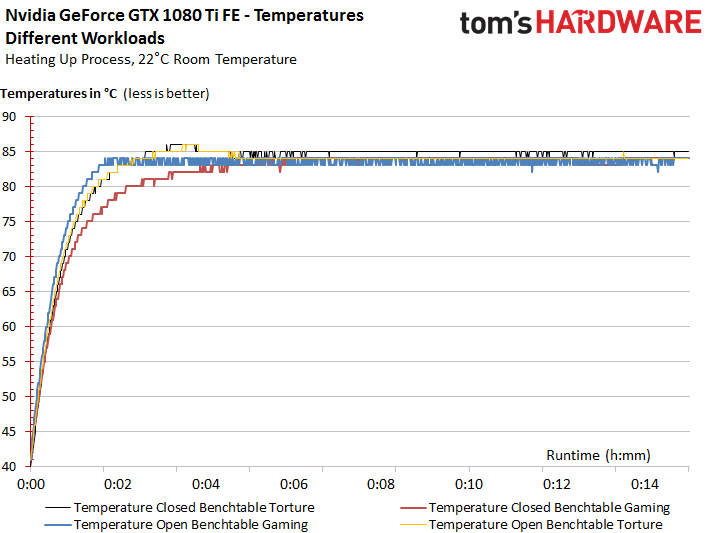
The card does hit a temperature limit, though. We know this due to the power consumption and clock rate results at different temperatures. Then again, Nvidia's Titan X (Pascal) did the same thing when we reviewed it.
Of course, it goes without saying that we’re using our high-resolution infrared technology to record temperatures around the card, since the GPU's thermal reading isn't the only one that matters. Other components play an important role too, and some of them get even hotter!
The Warm-Up Process
We ran the gaming and stress test loops on an open bench table and in a closed PC case, so we ended up with four datasets corresponding to one video each. Since the original videos would have gotten boring for you to watch in real-time, we sped them up by a factor of 10. The videos display only the GPU temperatures as their main measurement focus.
If the videos are either too fast or slow for you, we're also including the final results as stills for every scenario. In these, we added the voltage converter and memory module temperatures.
MORE: Best Graphics Cards
MORE: Desktop GPU Performance Hierarchy Table
Get Tom's Hardware's best news and in-depth reviews, straight to your inbox.
MORE: All Graphics Content
Gaming Loop
At idle or under a light load (browsing the Internet or watching a video), the fan spins leisurely at 1000 RPM or less. This is enough to keep temperatures nice and cool.
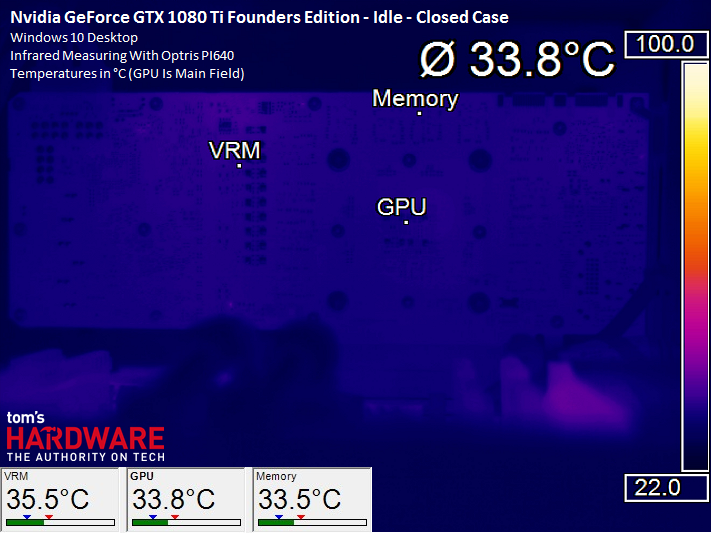
The temperature results under load demonstrate once again that it really doesn’t matter where you install the GeForce GTX 1080 Ti Founders Edition, thanks to its cooling solution.
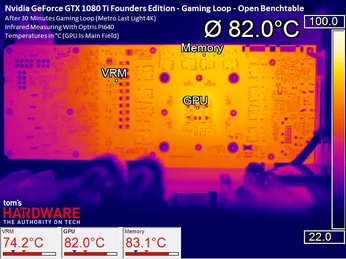
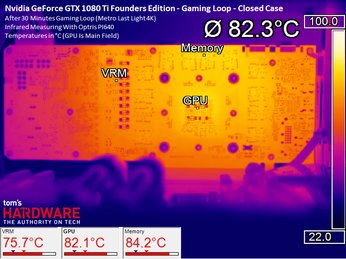
Stress Test Loop
The load might be different, but our infrared pictures appear unchanged. The memory modules do rise 1°C when switching from the open bench table to a closed PC case during both the gaming and stress test loops. However, with Micron’s GDDR5X memory modules rated for a maximum temperature of 95°C, the result isn’t even close to worrisome. Also, there aren't many enthusiasts who run FurMark recreationally.


The Founders Edition card's cooling performance is generally very good, especially when it comes to the voltage converters. However, Nvidia's reference design does reach a noise level that is quite noticeable.
MORE: Nvidia GeForce GTX 1080 Roundup
MORE: Nvidia GeForce GTX 1070 Roundup
Noise
The GeForce GTX 1080 Ti's operating noise after warm-up is obvious, but (just so) bearable. This is certainly not what we'd call a quiet graphics card. Let's have a look at the relationship between fan speed and temperature.
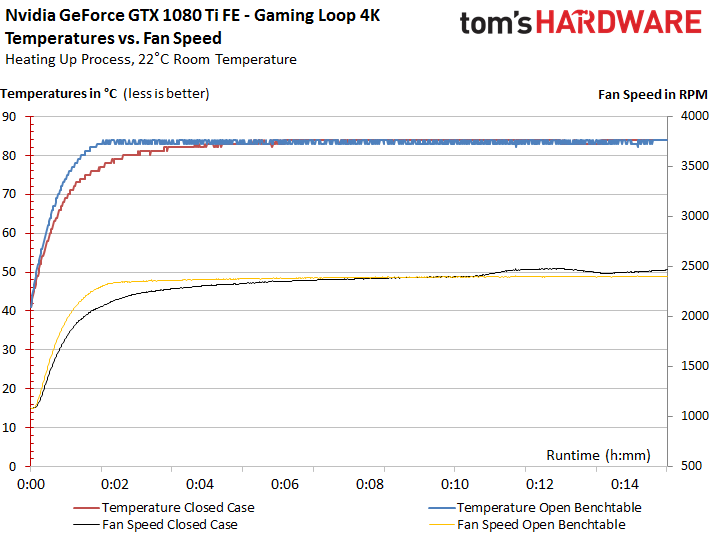
In a closed PC case, the fan has to make a noticeable push to to keep the temperature stable at Nvidia's configured ceiling once the card has been running for a while.
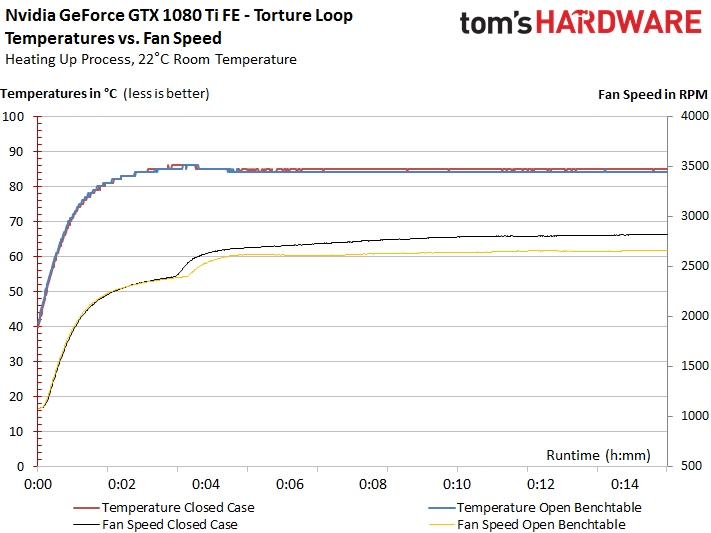
A direct comparison between Nvidia’s GeForce GTX 1080 Ti Founders Edition and Titan X (Pascal) yields almost no difference. The temperatures and fan speeds are practically identical during our gaming loop.
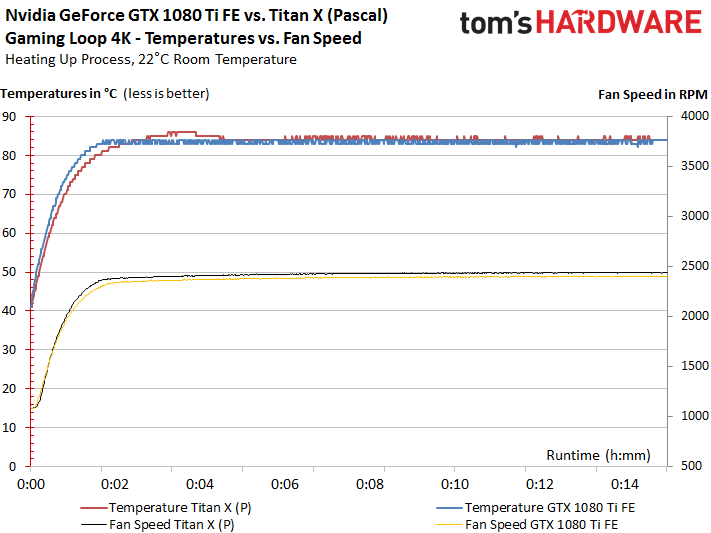
The only physical change to the Founders Edition card involves its rear exhaust, which is more free-flowing. Perhaps as a result, the 1080 Ti's noise profile is a little different compared to Titan X. Subjectively, however, there’s no difference between the two graphics cards, and their noise levels are almost the same as well. At full operating temperature, the 1080 Ti is slightly higher, despite a slower fan speed. Then again, its clock rate is a bit more aggressive as well, and there could always be slight manufacturing-related differences between the boards.

The noise level increases during our stress test. This is due to the temperature target the card must adhere to, no matter what.
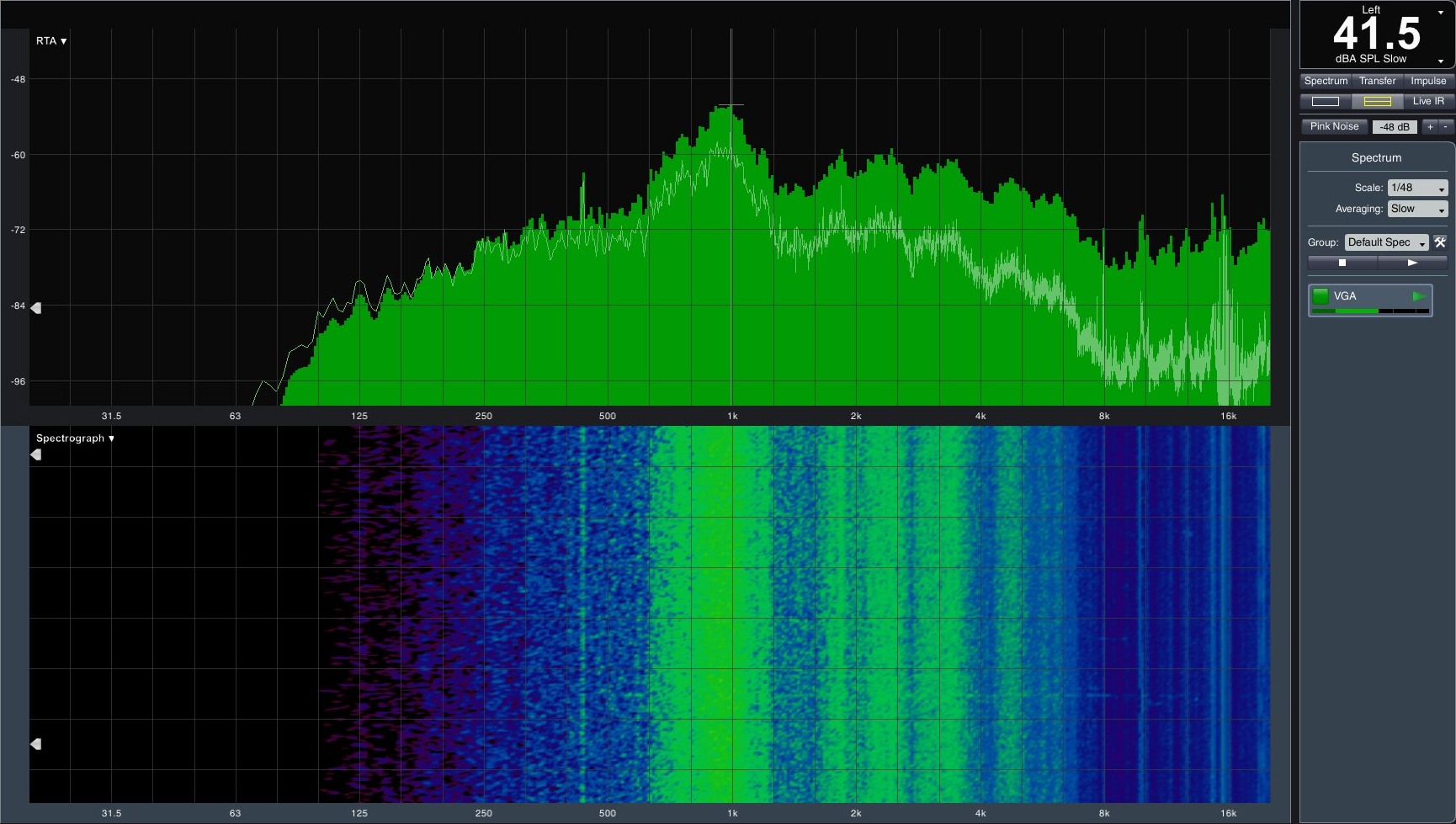
Bottom line: there’s really not much difference between Nvidia’s Titan X (Pascal) and its GeForce GTX 1080 Ti Founders Edition. This might be a good or a bad thing, depending on your point of view.
-
dstarr3 Oh my. I've got a 980 Ti now, and I thought I could hold out until Christmas 2018 or so to upgrade, but seeing that this card has nearly double the FPS... That's a pretty big deal...Reply -
HaB1971 Would love one, but pointless for 1080p gaming which is what I am restricted to thanks to 2 x 27inch 1080p monitors. I don't need to replace those either they work, they are good enough and not interested in VR etc. 4k for me, is still too priceyReply -
salgado18 Reply19401792 said:Oh my. I've got a 980 Ti now, and I thought I could hold out until Christmas 2018 or so to upgrade, but seeing that this card has nearly double the FPS... That's a pretty big deal...
Why not wait? Your card is still great, and you can pick up a 2080 or Vega 2 by then. Unless you can't live without 4K at Ultra, keep your card. -
Ray_58 Hab1971, 4k really isn't that bad price wise, its ok, part of the problem is the LCD panel industry milking the crap out of 1080p resolutions still up to the 300$ pricepoint when in actuality we should have been at base standard 2k TN/IPS panels at the 160$-300$ range. Still today though the greatest costs are the fact 60htz is still standard and any increase is massive price cost increases, and obviously Gsync for NVidia. Still spending $500-$800 on a monitor and then dropping 700$ on this is a bit 2 much for the mainstream. Id rather buy a 2k IPS screen with Gsync at 700$ than a 4k 60htz monitor at 400$Reply -
envy14tpe Reply19401792 said:Oh my. I've got a 980 Ti now, and I thought I could hold out until Christmas 2018 or so to upgrade, but seeing that this card has nearly double the FPS... That's a pretty big deal...
I feel the same. I see the jump in BF1 to be massive and enough to warrant a 1080 Ti for 1440p gaming. I'm holding out until June when the next Nvidia price drops. -
dstarr3 Reply19401838 said:19401792 said:Oh my. I've got a 980 Ti now, and I thought I could hold out until Christmas 2018 or so to upgrade, but seeing that this card has nearly double the FPS... That's a pretty big deal...
Why not wait? Your card is still great, and you can pick up a 2080 or Vega 2 by then. Unless you can't live without 4K at Ultra, keep your card.
Well, two reasons: 1) I'd like to upgrade to 1440p/144 this year. 2) I also have an HTPC with a 770 in it that needs an upgrade. I was considering buying a 1060 for that computer, but instead, I might just buy this 1080 Ti for my main rig and put its 980 Ti in the HTPC.
Either way, no purchasing until Christmas, because I hate paying full price for just about anything. So I've got time to think about this.




